标签:
要完成本演练,需要安装 Visual Studio 2010 或 Visual Studio 2012 或者更高。
如果使用的是 Visual Studio 2010,还需要安装 NuGet。
简单起见,我们将构建一个使用 Code First 执行数据访问的基本控制台应用程序。
可以看到当前的App.config 中的内容如下,等下可以作为参考:
1 <?xml version="1.0" encoding="utf-8" ?> 2 <configuration> 3 <startup> 4 <supportedRuntime version="v4.0" sku=".NETFramework,Version=v4.5" /> 5 </startup> 6 </configuration>
我们使用类来定义一个非常简单的模型。在 Program.cs 文件中进行定义,但是实际应用程序中,可能会将类分为若干个单独的文件,可能作为单独的项目。
在 Program.cs 中的程序类定义下,添加以下两个类。
1 public class Blog 2 { 3 public int BlogId { get; set; } 4 public string Name { get; set; } 5 6 public virtual List<Post> Posts { get; set; } 7 } 8 9 public class Post 10 { 11 public int PostId { get; set; } 12 public string Title { get; set; } 13 public string Content { get; set; } 14 15 public int BlogId { get; set; } 16 public virtual Blog Blog { get; set; } 17 }
可以看到,我们将虚拟化两个导航属性(Blog.Posts 和 Post.Blog)。这将启用实体框架的延迟加载功能。延迟加载意味着,尝试访问这些属性的内容时,将自动从数据库加载(virtual关键字)。
现在,可以定义派生上下文,用于表示数据库的一个会话,以便我们查询和保存数据。我们定义一个派生自 System.Data.Entity.DbContext 的上下文,并为模型中的每个类公开一个类型化 DbSet<TEntity>。
现在,开始使用来自实体框架的类型。因此,我们需要添加 EntityFramework NuGet 程序包。

1 <?xml version="1.0" encoding="utf-8"?> 2 <configuration> 3 <configSections> 4 <!-- For more information on Entity Framework configuration, visit http://go.microsoft.com/fwlink/?LinkID=237468 --> 5 <section name="entityFramework" type="System.Data.Entity.Internal.ConfigFile.EntityFrameworkSection, EntityFramework, Version=6.0.0.0, Culture=neutral, PublicKeyToken=b77a5c561934e089" requirePermission="false" /> 6 </configSections> 7 <startup> 8 <supportedRuntime version="v4.0" sku=".NETFramework,Version=v4.5" /> 9 </startup> 10 <entityFramework> 11 <defaultConnectionFactory type="System.Data.Entity.Infrastructure.LocalDbConnectionFactory, EntityFramework"> 12 <parameters> 13 <parameter value="v11.0" /> 14 </parameters> 15 </defaultConnectionFactory> 16 <providers> 17 <provider invariantName="System.Data.SqlClient" type="System.Data.Entity.SqlServer.SqlProviderServices, EntityFramework.SqlServer" /> 18 </providers> 19 </entityFramework> 20 </configuration>
App.config中增了的内容已经用黄色标注
增加了文件:
packages.config
<?xml version="1.0" encoding="utf-8"?>
<packages>
<package id="EntityFramework" version="6.1.3" targetFramework="net45" />
</packages>
在 Program.cs 顶部,为 System.Data.Entity 添加一个 using 语句。
using System.Data.Entity;在 Program.cs 中的 Post 类下,添加以下派生上下文。
1 public class BloggingContext : DbContext 2 { 3 public DbSet<Blog> Blogs { get; set; } 4 public DbSet<Post> Posts { get; set; } 5 }
完整Program.cs代码如下:
using System; using System.Collections.Generic; using System.Linq; using System.Text; using System.Threading.Tasks; using System.Data.Entity; namespace CodeFirstNewDatabaseSample { class Program { static void Main(string[] args) { } } public class Blog { public int BlogId { get; set; } public string Name { get; set; } public virtual List<Post> Posts { get; set; } } public class Post { public int PostId { get; set; } public string Title { get; set; } public string Content { get; set; } public int BlogId { get; set; } public virtual Blog Blog { get; set; } } public class BloggingContext : DbContext { public DbSet<Blog> Blogs { get; set; } public DbSet<Post> Posts { get; set; } } }
实现 program.cs 中的 Main 方法,如下所示。这些代码为上下文创建一个新实例,然后使用该实例插入新博客。之后,它使用 LINQ 查询检索数据库中的所有博客(按标题的字母顺序进行排序)。
1 class Program 2 { 3 static void Main(string[] args) 4 { 5 using (var db = new BloggingContext()) 6 { 7 // Create and save a new Blog 8 Console.Write("Enter a name for a new Blog: "); 9 var name = Console.ReadLine(); 10 11 var blog = new Blog { Name = name }; 12 db.Blogs.Add(blog); 13 db.SaveChanges(); 14 15 // Display all Blogs from the database 16 var query = from b in db.Blogs 17 orderby b.Name 18 select b; 19 20 Console.WriteLine("All blogs in the database:"); 21 foreach (var item in query) 22 { 23 Console.WriteLine(item.Name); 24 } 25 26 Console.WriteLine("Press any key to exit..."); 27 Console.ReadKey(); 28 } 29 } 30 }
按照约定,DbContext 已经创建了一个数据库。
这些仅仅是默认约定,除此之外,还有多种方式可更改 Code First 所用的数据库。有关更多信息,请参见DbContext 如何发现模型和数据库连接 主题。
可以在 Visual Studio 中使用服务器资源管理器连接至此数据库
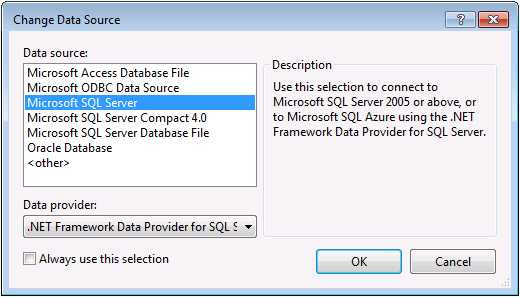
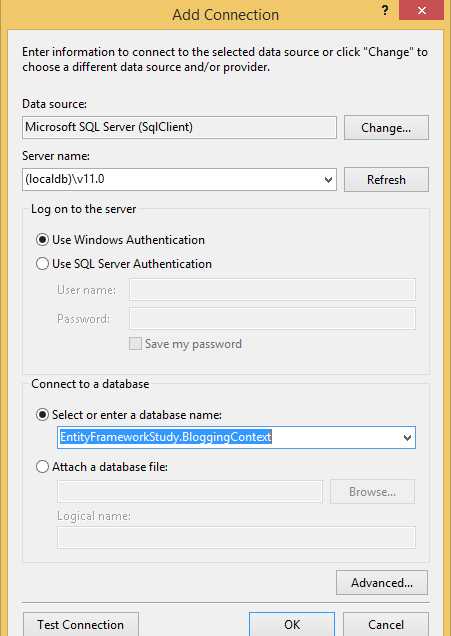
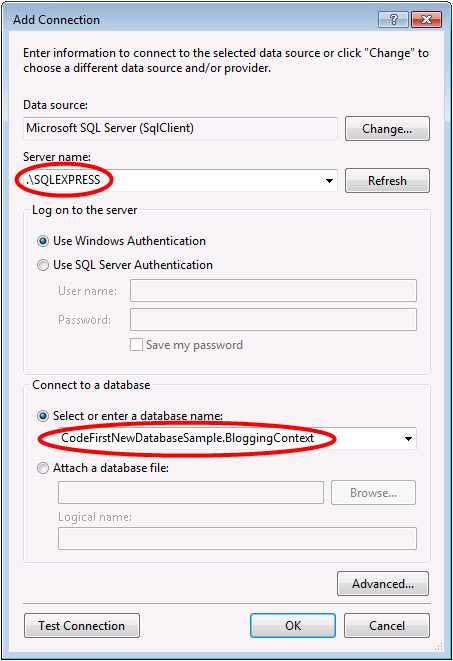
现在,可以检查 Code First 已经创建的架构。

DbContext 通过查看我们定义的 DbSet 属性,了解模型包含哪些类。随后,它使用 Code First 约定的默认集来确定表和列的名称,确定数据类型,查找主键等。本演练稍后将介绍如何重写这些约定。
现在更改模型,当我们进行更改时,还需要更新数据库架构。为此,我们使用一个称为“Code First 迁移”(或简称“迁移”)的功能。(Migration)
“迁移”是一组有序的步骤,描述如何升级(和降级)数据库架构。这些步骤(称为“迁移”)中的每个步骤均包含一些代码,用于描述要应用的更改。
第一步是为 BloggingContext 启用 Code First 迁移。
1 public class Blog 2 { 3 public int BlogId { get; set; } 4 public string Name { get; set; } 5 public string Url { get; set; } 6 7 public virtual List<Post> Posts { get; set; } 8 }
1 namespace CodeFirstNewDatabaseSample.Migrations 2 { 3 using System; 4 using System.Data.Entity.Migrations; 5 6 public partial class AddUrl : DbMigration 7 { 8 public override void Up() 9 { 10 AddColumn("dbo.Blogs", "Url", c => c.String()); 11 } 12 13 public override void Down() 14 { 15 DropColumn("dbo.Blogs", "Url"); 16 } 17 } 18 }
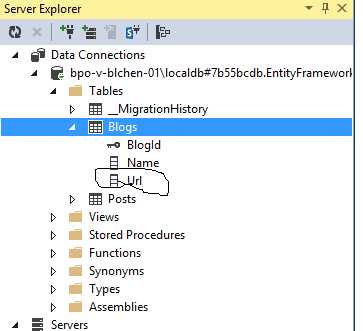
新的 Url 列已添加至数据库中的 Blogs 表:
到目前为止,EF 发现了使用其默认约定的模型。但是,有时类不遵从约定,我们需要能够执行进一步配置。对此有两种方法;本节将介绍数据注释,下一节将介绍 Fluent API。
public class User { public string Username { get; set; } public string DisplayName { get; set; } }
public class BloggingContext : DbContext { public DbSet<Blog> Blogs { get; set; } public DbSet<Post> Posts { get; set; } public DbSet<User> Users { get; set; } }
using System.ComponentModel.DataAnnotations;public class User { [Key]
public string UserId {get;set;} public string Username { get; set; } public string DisplayName { get; set; } }

EF 支持的完整注释列表为:
上一节介绍了如何使用数据注释来补充或重写按约定检测的内容。另一种模型配置方法是通过 Code First Fluent API。
大多数模型配置都可使用简单数据注释进行。Fluent API 是一种更高级的方法,除某些数据注释不可能支持的更高级配置外,可以指定包含数据注释所有功能的模型配置。数据注释和 Fluent API 可一起使用。
要访问 Fluent API,需要在 DbContext 中重写 OnModelCreating 方法。假设我们需要重命名 User.DisplayName 存储至 display_name 的列。
1 protected override void OnModelCreating(DbModelBuilder modelBuilder) 2 { 3 modelBuilder.Entity<User>() 4 .Property(u => u.DisplayName) 5 .HasColumnName("display_name"); 6 }
DisplayName 列现在重命名为 display_name: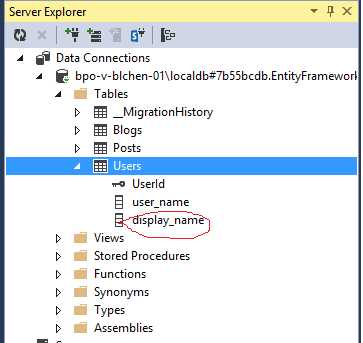
Entity Framework Code First 学习
标签:
原文地址:http://www.cnblogs.com/bleychen/p/4346760.html